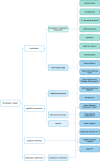How COVID-19 will boost remote exercise-based treatment in Parkinson's disease: a narrative review
- PMID: 33686074
- PMCID: PMC7940641
- DOI: 10.1038/s41531-021-00160-3
How COVID-19 will boost remote exercise-based treatment in Parkinson's disease: a narrative review
Abstract
The lack of physical exercise during the COVID-19 pandemic-related quarantine measures is challenging, especially for patients with Parkinson's disease (PD). Without regular exercise not only patients, but also nursing staff and physicians soon noticed a deterioration of motor and non-motor symptoms. Reduced functional mobility, increased falls, increased frailty, and decreased quality of life were identified as consequences of increased sedentary behavior. This work overviews the current literature on problems of supplying conventional physiotherapy and the potential of telerehabilitation, allied health services, and patient-initiated exercise for PD patients during the COVID-19 period. We discuss recent studies on approaches that can improve remote provision of exercise to patients, including telerehabilitation, motivational tools, apps, exergaming, and virtual reality (VR) exercise. Additionally, we provide a case report about a 69-year-old PD patient who took part in a 12-week guided climbing course for PD patients prior to the pandemic and found a solution to continue her climbing training independently with an outdoor rope ladder. This case can serve as a best practice example for non-instructed, creative, and patient-initiated exercise in the domestic environment in difficult times, as are the current. Overall, many recent studies on telemedicine, telerehabilitation, and patient-initiated exercises have been published, giving rise to optimism that facilitating remote exercise can help PD patients maintain physical mobility and emotional well-being, even in phases such as the COVID-19 pandemic. The pandemic itself may even boost the need to establish comprehensive and easy-to-do telerehabilitation programs.
Conflict of interest statement
The authors declare no competing interests (financial/non-financial).
Figures

Similar articles
-
Telerehabilitation: A Practical Remote Alternative for Coaching and Monitoring Physical Kinetic Therapy in Patients with Mild and Moderate Disabling Parkinson's Disease during the COVID-19 Pandemic.Parkinsons Dis. 2022 Aug 8;2022:4370712. doi: 10.1155/2022/4370712. eCollection 2022. Parkinsons Dis. 2022. PMID: 35979169 Free PMC article.
-
Effectiveness of Telerehabilitation on Motor Impairments, Non-motor Symptoms and Compliance in Patients With Parkinson's Disease: A Systematic Review.Front Neurol. 2021 Aug 26;12:627999. doi: 10.3389/fneur.2021.627999. eCollection 2021. Front Neurol. 2021. PMID: 34512495 Free PMC article.
-
Effectiveness of home-based and remotely supervised aerobic exercise in Parkinson's disease: a double-blind, randomised controlled trial.Lancet Neurol. 2019 Nov;18(11):998-1008. doi: 10.1016/S1474-4422(19)30285-6. Epub 2019 Sep 11. Lancet Neurol. 2019. PMID: 31521532 Clinical Trial.
-
Virtual Reality Telerehabilitation for Postural Instability in Parkinson's Disease: A Multicenter, Single-Blind, Randomized, Controlled Trial.Biomed Res Int. 2017;2017:7962826. doi: 10.1155/2017/7962826. Epub 2017 Nov 26. Biomed Res Int. 2017. PMID: 29333454 Free PMC article. Clinical Trial.
-
Virtual Reality, Augmented Reality, Gamification, and Telerehabilitation: Psychological Impact on Orthopedic Patients' Rehabilitation.J Clin Med. 2020 Aug 7;9(8):2567. doi: 10.3390/jcm9082567. J Clin Med. 2020. PMID: 32784745 Free PMC article. Review.
Cited by
-
Wearable biofeedback device to assess gait features and improve gait pattern in people with parkinson's disease: a case series.J Neuroeng Rehabil. 2024 Jun 26;21(1):110. doi: 10.1186/s12984-024-01403-z. J Neuroeng Rehabil. 2024. PMID: 38926876 Free PMC article.
-
A Taxonomy for Augmented and Mixed Reality Applications to Support Physical Exercises in Medical Rehabilitation-A Literature Review.Healthcare (Basel). 2022 Mar 30;10(4):646. doi: 10.3390/healthcare10040646. Healthcare (Basel). 2022. PMID: 35455824 Free PMC article. Review.
-
The Change in Exergaming From Before to During the COVID-19 Pandemic Among Young Adults: Longitudinal Study.JMIR Serious Games. 2023 May 22;11:e41553. doi: 10.2196/41553. JMIR Serious Games. 2023. PMID: 36952329 Free PMC article.
-
Feasibility, Safety, and Effectiveness of Telerehabilitation in Mild-to-Moderate Parkinson's Disease.Front Neurol. 2022 Jun 16;13:909197. doi: 10.3389/fneur.2022.909197. eCollection 2022. Front Neurol. 2022. PMID: 35785358 Free PMC article.
-
Social and psychological impact of the COVID-19 pandemic on people with Parkinson's disease: a scoping review.Public Health. 2021 Oct;199:77-86. doi: 10.1016/j.puhe.2021.08.014. Epub 2021 Sep 1. Public Health. 2021. PMID: 34571441 Free PMC article.
References
-
- Chaudhuri KR. COVID_19 and Parkinson’s disease. Kinetic. 2020;2:4–5.
Publication types
LinkOut - more resources
Full Text Sources
Other Literature Sources

